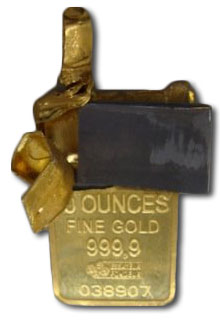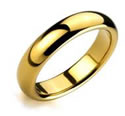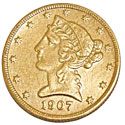Fooling with Gold
That's not chocolate candy peeking out of its foil wrapper. It's tungsten, a cheap metal, that was covered by a thin layer of gold and marked as real gold. The masquerade was discovered by a gold merchant in New York's diamond district earlier this year
It turns out that counterfeiting gold is easier than you might think. All that's necessary in this scam is to give tungsten a gold plating.
What is it about gold and tungsten?
Gold is an unusually heavy metal. It's specific gravity is 19.3 (meaning it is 19.3 times as dense as water). For comparison: lead, a common metal that most of us think of as heavy, has a specific gravity of only 11.35. If a lead bar – or piece of lead jewelry – were coated in gold, it would feel suspiciously light to an experienced jeweler or gold dealer. But tungsten, at 19.25, is almost as dense as gold. Gold-plated tungsten passes the weight test, it feels "right." A bar like this one also tests right chemically and passes an x-ray fluorescence scan, since its covering is gold.
A company in China has an extensive website advertising an array of tungsten items, including golf clubs, fishing weights, darts, etc., ... and gold-covered tungsten bars and jewelry. It always refers to these latter items as "gold-plated tungsten alloys" or "fake gold" or "gold substitute." Each page of the site carries a notice describing the company as a professional business and warning not to use its tungsten alloy products for illegal purposes.
The company's advertising addresses gold dealers and jewelers who might want fake gold items to display at trade shows, rather than risk the theft of their genuine gold pieces. A stockbroker might want to gift a client with a golden (-looking) egg. A big business could give out gold coins as souvenirs to VIP clients or fake gold bars engraved with the company name.
As for jewelry, "gold substitute is available in a wide range of colors, finishes and styles," and can even include gemstones. It looks right, it feels right and it's much more affordable than gold.
Disclosure is particularly important when a much cheaper material is made to look like an expensive one, especially when the substitute does not act like the real thing.
Gold-plated tungsten jewelry, besides lacking the inherent market value of gold, also has wearability issues. These caveats come from the manufacturer:
- Gold plating eventually wears away. How long this takes depends on the thickness of the plating and how much the item is worn.
- Perspiration causes the tungsten fake gold to lose its color and sheen.
- If a fake gold item is dropped or struck with a hard object it can break because tungsten is much more brittle than gold.
- Cleaning with steam, ultrasound, or various chemical cleaners can cause spotting and corrosion; only soap and water should be used.
- Leaving wet jewelry to air-dry will cause spotting; jewelry must be dried with a cloth.
So, this manufacturer is being up-front about the content and durability of its products and also is not encouraging illegal activity. But disclosure must be present all the way down the selling chain, from manufacturer through to the consumer and insurer. Someone with deceit in mind can easily interrupt that flow and pass off counterfeit gold jewelry as the real thing. Also, where there is one manufacturer, there are likely to be others, now or in the near future.
The gold-coated bar pictured above was definitely an attempt at fraud, and the FBI and Secret Service are investigating the incident. So far no reports have surfaced of counterfeit gold jewelry being passed as genuine, but consumers and insurers should be on guard. With the high price of gold and the low cost of tungsten, this looks like a scam waiting to happen.
FOR AGENTS & UNDERWRITERS
Tungsten certainly isn't "as good as gold." A recent comparison had an ounce of gold worth $1,766, while an ounce of tungsten was worth about 25 cents!
There are simple ways to test for the presence of tungsten. For example, tungsten will be drawn to a magnet while gold will not be. A trained jeweler will be aware of other tests.
A reputable jeweler deals with reputable suppliers who stand behind their products. Be wary of insuring jewelry from questionable sources, such as website auctions and second-hand sellers.
Jewelry purchased in tourist locations often does not measure up to the stated quality. These locations are perfect settings for fraud, since the buyer cannot comparison shop or have the purchase examined by an independent appraiser.
An appraisal for jewelry containing gold should include karatage, manufacturer and style number, workmanship, and weight of the piece.
Be suspicious if jewelry is called gold but the manufacturer's name is not given on the appraisal. Jewelry stamped with karatage must, by law, bear the manufacturer's trademark. The appraiser should list the owner of that trademark (that is, the manufacturer) on the appraisal.
The best defense against scams, or retailer incompetence, is the insurance industry's standard for jewelry appraisals, JISO 78/79. The appraisal should be written by a trained gemologist (GG, FGA+, or equivalent) with additional insurance appraisal training. One course offering such additional training is the Certified Insurance Appraiser™ (CIA) course of the Jewelry Insurance Appraisal Institute, Oakland, CA.
FOR ADJUSTERS
If the appraisal is not on JISO 78/79, use JISO 18 (Jewelry Appraisal and Claim Evaluation) to check that all necessary information is given.
If there is inadequate information on file, perhaps a poor appraisal or merely a sales receipt, a jewelry insurance expert may be consulted before settling the claim.
Note: Gold jewelry comes in a variety of shades, depending on the alloys added to increase its strength and make it more suitable for jewelry. Manufacturers may add a coating of rhodium to a finished piece of white gold jewelry to make it a "whiter white." As this coating wears off, the gold's off-white color will reappear. Such jewelry is genuine gold, not to be confused with a gold substitute like tungsten. However, a rhodium coating that wears off is considered normal wear and tear, not damage for which the insurer is liable.
©2000-2025, JCRS Inland Marine Solutions, Inc. All Rights Reserved. www.jcrs.com





